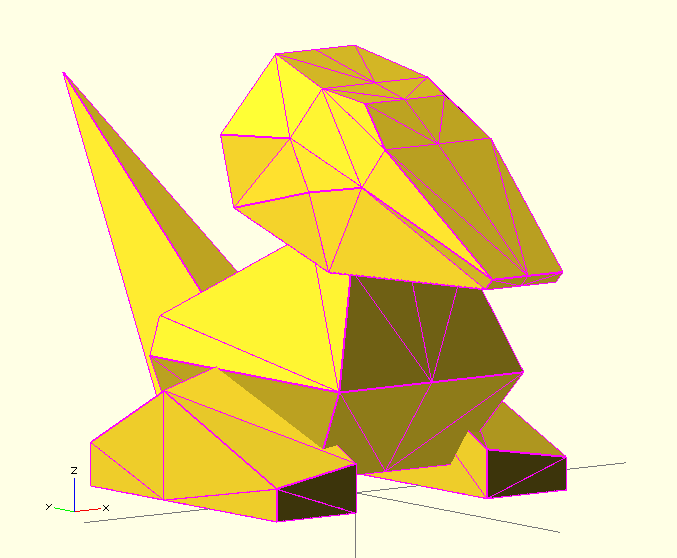
There you go. Porygon made completely in computer code. Here's the code listing:
//Porygon, made with OpenSCAD polyhedrons
module bodyHalf()
{
polyhedron(
points=[ [16,31,5], [0,31,5], [0,34,23], [0,35,30],
[18,35,30],[21,34,23], [21,-23,23],[11,-1,49],
[0,-1,49], [13,-16,44],[0,-16,44], [0,-23,23],
[0,-9,5], [16,-9,5]],
faces=[ [0,2,1], [0,5,2], [2,5,4], [3,2,4], [4,5,6],
[7,8,3], [3,4,7], [4,6,7], [8,7,9], [7,6,9],
[10,8,9], [6,11,9],[10,9,11],[11,6,12],[6,13,12],
[13,5,0], [6,5,13],[0,1,12], [12,13,0]]
);
}
module tail()
{
translate([0,-5,0])
polyhedron(
points=[ [0,90,67],[6,37,30], [-6,37,30],[13,40,5],
[-13,40,5], [13,32,5], [-13,32,5]
],
faces=[ [0,1,2], [0,3,1], [0,2,4], [0,4,3],[1,3,5],
[4,2,6], [3,6,5], [3,4,6],[1,6,2], [1,5,6] ]
);
}
module footLeft()
{
polyhedron(
points=[[40,-20,0], [22,-20,0], [22,36,0], [40,36,0],
[22,36,13], [40,36,8], [40,-20,6], [22,-20,9],
[40,14,20], [22,14,25], [40,14,0]],
faces=[ [2,1,0], [0,3,2], [2,3,4], [5,4,3], [1,6,0],
[6,1,7], [6,7,8], [9,8,7], [9,5,8], [4,5,9],
[0,6,10], [10,6,8], [5,3,10], [10,8,5], [4,9,2],
[2,9,1], [1,9,7]
]
);
}
module headhalf()
{
polyhedron(
points = [[18,-16,44], [0,-16,44], [8,-50,44], [8,-52,46],
[0,-50,44], [0,-52,46],[15,-22,60], [12,-25,67],
[0,-25,67], [0,-15,74], [9,-15,74], [12,-6,76],
[0,-6,76], [17,-3,67], [18,-10,58], [20,10,53],
[20,14,66], [9,12,80],[0,12,80], [0,14,66],
[0,10,53]
],
faces = [ [0,1,2], [1,4,2], [2,4,3], [4,5,3], [0,2,6],
[8,7,5], [3,5,7], [6,3,7], [2,3,6], [7,10,11],
[7,8,10], [8,9,10], [9,11,10], [9,12,11],
[6,7,11], [6,11,13], [6,13,14], [6,14,0],
[0,14,15], [14,13,15], [13,16,15], [13,17,16],
[13,11,17], [11,12,17], [17,12,18], [17,18,19],
[19,16,17], [15,16,20],[20,16,19], [20,0,15],
[1,0,20],
]
);
}
module body()
{
union()
{
bodyHalf();
mirror([1,0,0])
{
bodyHalf();
}
}
}
module feet()
{
union()
{
translate([-7,0,0]) footLeft();
mirror([1,0,0]){
translate([-7,0,0]) footLeft();
}
}
}
module head()
{
union()
{
headhalf();
mirror([1,0,0])
{
headhalf();
}
}
}
module porygon()
{
union()
{
head();
body();
tail();
feet();
}
}
porygon()
I'll be pushing this up to the Git in a bit, along with models that are good enough for printing.
 Benchoff
Benchoff
Discussions
Become a Hackaday.io Member
Create an account to leave a comment. Already have an account? Log In.
I tried out OpenSCAD today and used your code (a semicolon is missing at the end, btw). I tried to export it but always get a "Object may not be a valid 2-manifold and may need repair!" - did you get the same? Thanks for sharing.
I've made a little addition to your code, so one can resize by height:
module porygon(size=50)
{
scale([size,size,size])
resize([1,0,0], auto=true)
union()
{
body();
head();
tail();
feet();
}
}
porygon();
Are you sure? yes | no
Yeah, it actually needs a lot of work to be a printable file. If you screw with it in meshlab you can make it work.
Are you sure? yes | no